




the staff editor-in-chief holly funk editor@carillonregina.com
business manager thomas czinkota business@carillonregina.com production manager shae sackman production@carillonregina.com advertising manager holden norrie ads@carillonregina.com communications mehrnoush bahramimehr comms@carillonregina.com technical editor vacant tech@carillonregina.com multimedia/graphics editors multimedia@carillonregina.com safal gangwani graphics@carillonregina.com lee lim copy editor aurel dumont copyeditor@carillonregina.com news editor gillian massie news@carillonregina.com a&c editor wren gessner arts@carillonregina.com s&h editor vacant sports@carillonregina.com op-ed editor hammad ali op-ed@carillonregina.com distribution manager chandra wassill distribution@carillonregina.com staff writer amina salah staff writer victoria baht staff writer bodie robinson news writer josh king a&c writer jorah bright s&h writer sophia stevens
contributors adam baker-smith, katlyn richardson, navjot singh board of directors holly funk, jacob nelson, and honourary members: shiva souri, jorah bright, hammad ali, shae sackman, amina salah and thomas czinkota

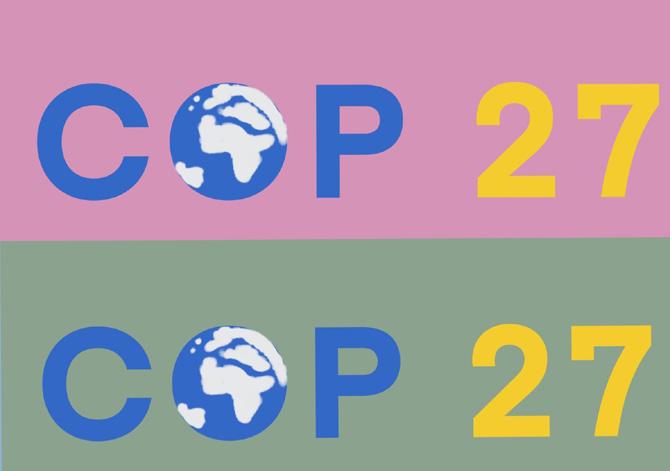
It’s still COVID’s world, and we’re just living in it. With a scarcity of public health mea sures and supports around, we encourage you to think back to the practices followed before COVID had killed even a single person here. Mask up to keep yourself and others safe, keep up to date on your COVID vaccinations and boosters to improve your chances against infection, and try switching what in-person meetings you have to video conferencing platforms when possible. We’ve been here before, we know what to do here, and unfortunately it’s likely we’ll stay here until we accept that it’s where we are. Until then, we’ll be here reporting on the good, the bad, the ugly, and everything in between.
the paper
227 Riddell Center University of Regina - 3737 Wascana Parkway, Regina, SK, Canada S4S 0A2 www.carillonregina.com Ph: (306) 586 8867
Printed by Star Press Inc, Wainwright, AB
The Carillon welcomes contributions.
Opinions expressed in the pages of the Carillon are entirely those of the author, and do not necessarily reflect those of the Carillon Newspaper Inc. Opinions expressed in advertisements appearing in the Carillon are those of the advertisers, and not necessarily of The Carillon Newspaper Inc. or its staff.


The Carillon is published no less than 11 times each semester during the fall and winter semesters and periodically throughout the sum mer. The Carillon is published by the Carillon Newspaper Inc., a non-profit organization.


The Carillon is written on treaty four territory. As such, the staff recognize that we are living, working, and telling stories on and of Indigenous lands. We recognize that we are on the traditional homelands of the Nakota, Lakota, and Dakota peoples, along with the homeland of the Métis nation. The Carillon understands that it is pointless to acknowledge the land on which we work without speaking to our commitment to telling stories and prioritizing voices that further the return of the land to its place sacred place in the cultures of those that live here.
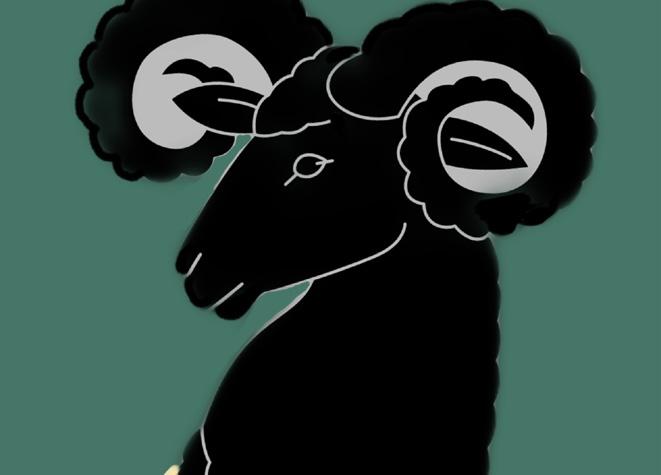
the manifesto
In keeping with our reckless, devil-may-care image, our office has absolutely no concrete information on the Carillon’s formative years readily available. What follows is the story that’s been passed down from editor to editor for over sixty years.
In the late 1950s, the University of Regina planned the construction of several new buildings on the campus grounds. One of these pro posed buildlings was a beltower on the academic green. If you look out on the academic green today, the first thing you’ll notice is that it has absolutely nothing resembling a belltower.
The University never got a belltower, but what it did get was the Car illon, a newspaper that serves as a symbolic bell tower on campus, a loud and clear voice belonging to each and every student.
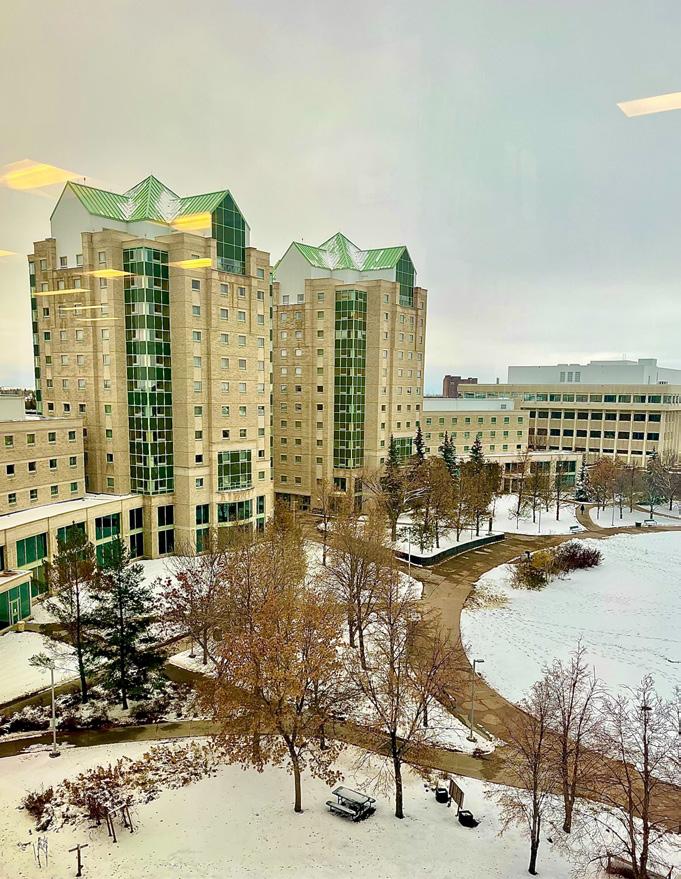
“We are on a highway to climate hell with our foot still on the ac celerator,” said United Nations Secretary-General António Gu terres this week, warning world leaders about the dangers of a changing climate.
From flooding in Pakistan to heat waves in Europe, climate change has been on many minds in 2022. This week, world lead ers, scientists, and activists met to discuss these impacts. The 27th annual Conference of the Parties of the United Nations Frame work Convention on Climate Change, also known as COP27, started November 7. Despite not yet being finished, there have al ready been several bombshell announcements about climate change at the Coca-Cola spon sored conference.
Starting one week before the conference, the UN’s envi ronmental programme released a report stating there is now “no credible pathway” to keep global warming below 1.5 C, a target that countries have committed to staying below since the 2015 Paris Agreements. The calling for action the report states: “Only an urgent system-wide transforma tion can avoid an accelerating cli mate disaster.”
The crossing of a critical threshold was echoed by Guterres in his opening remarks.
“In just days, our plan et’s population will cross a new threshold,” said Guterres. “The eight billionth member of our human family will be born. This milestone puts into perspective what this climate conference is all
Climate reparations have become one of the dominant themes of the conference’s first week. This differs significantly from COP26, where climate rep arations never made it onto the formal agenda for the talks. The change in focus is largely due to the talks being held in Egypt this year, rather than Glasgow in the year previous, and a diplomatic push by many African countries to include reparations in the dis cussions. However, before the summit, diplomats have come to an agreement to not debate blame while still considering the damage and keeping climate rep arations on the bargaining table.
Canada’s Environment and Climate Change Minister Steven Guilbeault told CBC: “It can’t be about liability. Developed nations cannot sign onto something that would make the Canadian public and the European public and the American public liable for lord knows how many hundreds of billions of dollars of damages.”
On the contrary, the United Nations Climate Change Exec utive Secretary Mr. Simon Stiell vowed in his opening speech: “We will be holding people to ac count.”
Worldwide, the commit ments of countries to reducing greenhouse gas emissions falls far short, and the UN realistically has little if any enforcement power. Reflecting on COP26 last year in a press release, the UN reported “NDCs [Nationally Determined Contributions] submitted this year take only 0.5 gigatonnes of CO2 equivalent, less than one per cent, off projected global emis sions in 2030.”
This comment is in the con text of Canada currently being in
own panel.
As reported by Global Wit ness, an environmental NGO, there are twice as many fossil fuel lobbyists at COP27 as there are delegates from the UN Constitu ency for Indigenous Peoples. The same report states that there are over 100 more fossil fuel lobbyists
Project (MECCE), whose project manager, Nicola Chopin, is based at the University of Saskatchewan and is a representative at COP27.
Kristen Hargis, a research asso ciate with MECCE, described MECCE as “an international partnership focused on increasing the quantity and quality of ACE
ada’s score isn’t looking so great. One of MECCE’s nine indicators is “Adult willingness to participate in climate action,” on which Can ada scores a 1 out of 5. This is in contrast to our scores on several education and awareness indi cators being above a 3 out of 5. While the Canadian populous
about. How will we answer when ‘Baby 8 Billion’ is old enough to ask: ‘What did you do for our world – and for our planet – when you had the chance?’”
The same report that claimed we are now likely to cross 1.5 C of warming points out how inad equate climate policy, particularly in high-income countries which have released a disproportionate amount of carbon dioxide into the atmosphere, is responsible. It is this disproportionate effect on the climate that has led to the discussion of climate reparations, the idea that high-income coun tries will give support to low-in come countries suffering from climate change.
the top 10 emitters of greenhouse gases when measured per capita, according to the World Bank in 2019. But Canada isn’t escap ing notice on the world stage. A coalition of Indigenous groups known as Keepers of the Water will be bringing their concerns to COP27 about Alberta’s plan to expand coal mining in the Rocky Mountains. Though, their single representative who is a part of the Indigenous Climate Action delegation may be overshadowed by the eight representatives of the five largest oil-sand companies who get their own place in the Government of Canada’s official pavilion and will be hosting their
than at the previous COP26.

Despite the global stage, humble Saskatchewan has some of our own headed to COP27. Firstly, a Northern Saskatchewan high school student, Sean Ber nard from Waterhen Lake First Nation, is headed to Egypt as a youth delegate. He is a grade 12 student who will be making the trip with his high school teacher. He will be one of only five youth delegates who get to participate in the major negotiations.
Researchers in Saskatche wan are also attending the confer ence. I reached out to the Mon itoring and Evaluating Climate Communication and Education
[Action for Climate Empower ment] globally.”
ACE is a standard that MECCE uses to measure “six el ements: education, public aware ness, training, public participa tion, public access to information, and international cooperation.”
MECCE sees the “critical im portance of Action for Climate Empowerment (ACE) in enabling the social and political will need ed to achieve just transitions to post-carbon societies.”
Just ahead of COP27, MEC CE has released their interactive data platform which tracks a country’s progress on ACE. Sim ilar to our GHG emissions, Can
seems to be aware of climate change, as a whole we apparently share Guilbault’s opinion about not accepting liability.
Despite all the doom and gloom, many at the conference are there because they believe that implementing the necessary changes can still make a better life for everyone. As stated at the opening remarks, Mr. Sim one Stiell said “Our minds have moved from researching to un derstanding, and then to agreeing on a plan. Now we know what must be done […] by everybody, everywhere, every single day, do ing everything we possibly can. Let’s get to work.”
Image: Lee Lim– António Guterres, United Nations Secretary-General
The Sask. Party introduced the Saskatchewan First Act on No vember 1. According to an an nouncement by the provincial government, the Saskatchewan First Act will “confirm Saskatch ewan’s autonomy and exclusive jurisdiction over its natural re sources.”
The Act will attempt to amend the Constitution of Sas katchewan to confirm the prov ince’s “sovereign autonomy.” Specifically, the legislation will assert the province’s jurisdiction over the exploration and develop ment of non-renewable natural resources, forestry, and the “op eration of sites and facilities for the generation and production of electrical energy.”
The Saskatchewan First Act has its own motto: ‘drawing the line.’ The Sask. Party has long claimed that the federal govern ment’s environmental regulations encroach on the province’s right to explore and develop natural resources, especially in the oil and gas sector. The message is clear: the Saskatchewan govern ment is drawing the line against Trudeau’s carbon tax and other green strategies to reduce carbon emissions.
The legislation derives much of its content from a white paper released by the Sask. Party in Oc tober. The white paper caused controversy for its provocative rhetoric and dubious economic claims – a phenomenon unoffi
cially named “Moe math.”
The white paper claims that the federal government interferes “in the province’s jurisdiction over natural resources under the guise of federal environmental regulation.” Further, this inter ference causes serious economic damage to Saskatchewan: “If this continues it will have an extreme ly detrimental impact, costing Saskatchewan’s economy $111 billion by 2035.” This figure has been widely disputed by nonpar tisan analysts, economists, and various journalists. But the math may not matter. Political theatre rallies the base far better than numbers do.
Garry Ewart, a political sci ence professor at the University of Regina, sat for an interview with the Carillon to discuss the white paper. “It’s basically saying that we [Saskatchewan] are an equal partner with Canada under the constitution, […] it’s designed to put forth that autonomy in Sas katchewan,” Ewart said. “This white paper was possibly bound to happen with the animosity be tween the provincial and the fed eral governments ever since the Supreme Court ruling on the car bon tax. Ever since that, there’s been uneasiness.”
Commenting on the provoc ative rhetoric used in the white paper, Ewart said “It has hit an all-time high for rhetoric between the province and the federal gov ernment, […] ‘Drawing the line,’ as they say.” But the Sask. Party may also be feeling pressure with in the province, too. Ewart went
on to say that “With the political landscape in Saskatchewan, you have the rise of other parties, like the Buffalo Party, and so on. I think, to some extent, that is why the [Sask. Party] is trying to keep those votes from going to other parties by appealing to a broader group of people.”
With this in mind, the white paper seems to make a little more sense. The white paper’s purpose is for the provincial government to reassert jurisdiction over Sas katchewan’s natural resources. But in reality, the provincial gov ernment is attempting to reassert jurisdiction over something it al ready controls.
Again, Ewart thinks many of the claims in the white paper are about politics: “These are already issues that are within the provin
cial jurisdiction. So, a lot of it is, I would say, purely political. And, again, to get their base of people and other groups to come back into the [Sask. Party’s] political frame.”
Regarding the dubious math in the document, Ewart stated that the Sask. Party may be will ing to risk credibility to arouse a strong reaction from its base. The white paper claims federal envi ronmental regulations will cost the Saskatchewan economy $111 billion by 2035. Even though this figure has been disputed, that may not be the point. Ewart said “It’s a number that would make people take notice, even if it is wrong. The issue now is that the onus is on opposition groups and the opposition party to prove that that number is wrong.”
The fundamental issue in the white paper is natural resources and the question of who actual ly controls them. Ironically, the white paper makes no mention of First Nations, who undeniably have prime stake in the natural resources of Saskatchewan. Ew art emphasized time and again that this is an inexcusable over sight by the Sask. Party: “One comment that I mentioned but can’t say enough is that First Na tions Peoples were not mentioned or consulted.”
Mostly politics, little sub stance; the white paper’s lack of credibility and its bold rhetoric makes it more like demagoguery than reliable economic policy. “It’s an interesting document, but I think it will fade with time,” Ew art concluded
In January 2022, Regina joined many cities worldwide with their release of an action plan to make the city “a one-hundred per cent renewable energy community

by 2050.” The Energy and Sus tainability Framework was first voted on by city council in 2018. However, it has been a long and rocky road to finally publishing Regina’s action plan. According to Sask Dispatch, in January 2020 the city invited a climate denier to be a keynote speaker at their
climate conference. Shortly after, the pandemic hit Canada just as the report’s analysis was being completed. Through all the hur dles, the monstrous 100+ page framework was published.
As a recent report reflecting on the Energy and Sustainability Framework emphasizes, the work isn’t over; it is just beginning. The report, titled Implementing Eq uity, was published by University of Regina professor Emily Eaton and Director of the Saskatche wan Office of the Canadian Cen tre for Policy Alternatives Simon Enoch. The report praises Regina for putting an emphasis on equity in their framework. Compared to other cities, the report states that in 2020, out of 267 cities ana lyzed with a plan to transition to net-zero, only four had men tioned equity. They concluded that “a startling number still fail to include equity in any mean ingful way, often relegating equity concerns to secondary or tertiary goals”
Regina’s plan sets out seven ‘big moves’ as the key areas to be targeted, which include goals such as new construction hitting net-zero and powering indoor heating with renewable sources. As a part of the equity commit ment Regina is being lauded for, each ‘big move’ also includes eq
uity co-benefits. On top of the ‘big moves,’ there are also 31 ad ditional moves Regina has com mitted to taking, 23 of which are supposed to be planned or started by the end of 2023. I contacted the City of Regina to ask about what actions they’ve already tak en, but there was no reply as of publishing this article.
In the report by Eaton and Enoch, each ‘big move’ was giv en some recommendations for how to implement it in an equi table way. For example, they rec ommended creating an electric vehicle (EV) car-share program to meet the low-emission vehi cle target. Eaton and Enoch also had recommendations for how to fund Regina’s ‘big moves.’
One idea that other munic ipalities have come up with is charging additional stormwa ter fees to properties with large amounts of paved area. The rea soning being that pavement pre vents stormwater from absorbing into the soil, which means that more of it ends up in stormwater drains. This would have the dou ble benefit of raising funds while also encouraging more greens pace within the city. Other ideas include taxing programs like Uber who currently use public infrastructure paid for by Regina, like roads, without paying back
the community.

The primary recommenda tion made by Eaton and Enoch is for a sustainable equity commis sion to be set up by the City of Regina to ensure equitable imple mentation over time. Implement ing Equity states “continued com munity engagement is the best way to ensure that those concerns are implemented.”
I also reached out to CUPE Local 21, a local union whose member Tyler Hutchinson ad vised on the city’s Energy and Sustainability Framework. When asked about the framework’s im pacts on workers, Hutchinson said “how the city implements the program will dictate what kinds of impacts it will have on mem bers, […] though Local 21 is gen erally in favour of renewable.”
Having a committee is thought to be important not just for equity, but also for keeping the city’s plan on track. In several other municipalities, sustainabili ty goals have been derailed by not considering the needs of the com munity. When interviewed by the Regina Leader-Post, Eaton said “The fear is if climate policies are perceived as unfair or unjust that they will invite opposition and backlash.”
‘Big moves’ ahead for our little city on the prairies
Regina has a great number of or ganizations that provide services and resources to help individuals in our city. Last week, the Carillon interviewed Aids Programs South Saskatchewan about services they provide, like harm reduc tion education. This week, Mo bile Crisis Services will be added into the mix. According to their website, Mobile Crisis Services is a non-profit community-based organization that aims to provide comprehensive practices with so cial and health crisis intervention services. They provide a great deal of different services that work on a 24-hour, seven-days-aweek basis.
Some services to take note of
for almost 38 years. The compa ny provides almost all emergen cy social services to Regina after hours, including evenings, week ends, and holidays. Mobile Crisis Services can help individuals with services like child welfare, emer gency financial assistance, mental health intervention, emergency counselling, and domestic vio lence intervention. The following interview with Thorson gives an overview for how you can access services for yourself or others, and a bit about how responders from these services act on scene.
Mobile Crisis Services must have plenty of workers on hand to provide services. Can you explain what kind of education your workers may have to help individuals feel safe when contacting you?
son you are talking to; we do not transfer. Anyone who answers the phone here should be able to help you with whatever your issue is.
if we are called to a fire and we are going to make arrangements for the family to move for accom modations, […] we would make
officers were doing social work in the middle of the night because there was nowhere for them to take people. […] So, then there
right off the hop are Mobile Crisis Helpline, Crisis Suicide Helpline, Mental Health, and Wellness. The team appears to work to gether towards a common goal of helping individuals involved with a wide range of crises. The Carillon spoke with Janet Thorson to see what they have to say about the organization.
Thorson is the executive di rector of Mobile Crisis Services. They have been with the agency
When we are hiring candi dates must have a degree, and we prefer those degrees be in a related area. This can include Social Work, Human Justice, Psy chology, Psychiatric Nursing. […] Then the way we set up our agen cy is that our staff is trained in all areas that we work in. We provide 400 hours of training to anyone that is hired on with us, and who ever answers the phone is the per
What are some good things the organization can be rec ognized for? How is this or ganization working hard to help individuals in our com munity?
Well, we don’t really look for recognition. A true value of our agency is confidentiality. We want to protect our clients from public ity or exposure. So, for example,
every effort for those people to assure they are in a safe place and not exposed to any publicity if they do not want to be.
Same with our staff, we don’t identify ourselves. If you see a major scene in the city, you’ll see fire, ambulance, and police; we will be there too, but you won’t notice us as we will be dressed as civilians. […] Because we are pro viding a different service, we con sider ourselves first responders.
Based on your website, you offer 6 main helplines and 11 programs and services. Let’s talk about one specifically. What do you do, and what should one expect when they approach a helpline or a pro gram from your team?
Let’s talk about Emergency Financial Assistance. We have a contract with the Ministry of So cial Services to provide emergen cy financial assistance after hours. So, that means if we are put in a position, we can write someone a food voucher or help them with accommodations. […] Our con tract says that we will help a client get to the next working day, and at the point where the expectation is that they will approach the Minis try of Social Services. […] We do a mini-assessment with everyone to assure that we are providing the correct help in a timely way.
Can you explain why a ser vice like this is highly im portant for our community to have?
I think it is critical, and I think if you asked our first re sponding partners like fire and police they would agree. The rea son why Mobile Crisis Services was created, […] many police

was an approach to the Ministry of Social Services in the mental health clinic, and formed a com mittee and created Mobile. The idea was we would assist in the social side. So, for example, when looking at a domestic, the po lice would deal with the charges, then we will take the family and provide emergency accommoda tions. […] We pick up from the police and the fire. They do their job, but the client still needs help with the social problems and we take it from there.
What are some benefits peo ple can gain from accessing your services?

The main benefit people can gain, for example dealing with more counselling issues, is that we can open up the door to them that other services that are out in the community that they may not be aware of. One thing we are good at here is a referral, so if you phone us and you have a problem and want more help than what we can give you on an emer gency basis, we can refer you to counselling, Aids Program South Saskatchewan, the Regina Sexu al Assault Centre, and more. […] They can talk to us on the short term then we can make a refer ral, we give the number and en courage them to call. We are not just talking to you for 30 minutes and letting you go. We are mak ing sure you have somewhere to go afterwards.
Mobile Crisis Services are available at all hours. Thorson said their call line is always open: “If you have a problem, just give us a call. As I say, if we are not the people to help you, we will try to figure out who can.”
“We are not just talking to you for 30 minutes and letting you go. We are making sure you have somewhere to go afterwards.”
– Janet Thorson
From August 6 to November 13, 2022, the Mackenzie Art Gallery presented an exhibition called Conceptions of White. The exhibition was curated by the Mackenzie Art Gallery’s Execu tive Director and CEO John G. Hampton and the Gallery 44’s Curator of Exhibitions and Pub lic Programming Lillian O’Brien Davis.
Conceptions of White fo cused on White people, centring in on ideas of the “White race” and the myths behind it. It follows feelings of “white guilt, anxiety, supremacy, benevolence, fragility, and power.” It sees Whiteness as something created by colonizers and something that has been so cially constructed.
Seeing this exhibition cu rated by Hampton and O’Brien Davis was incredible. The setup was great; it was impactful. You walk into a room filled with white. White statues and white art piec es. Black backgrounds to offset it. Every use of colour feels deliber ate.
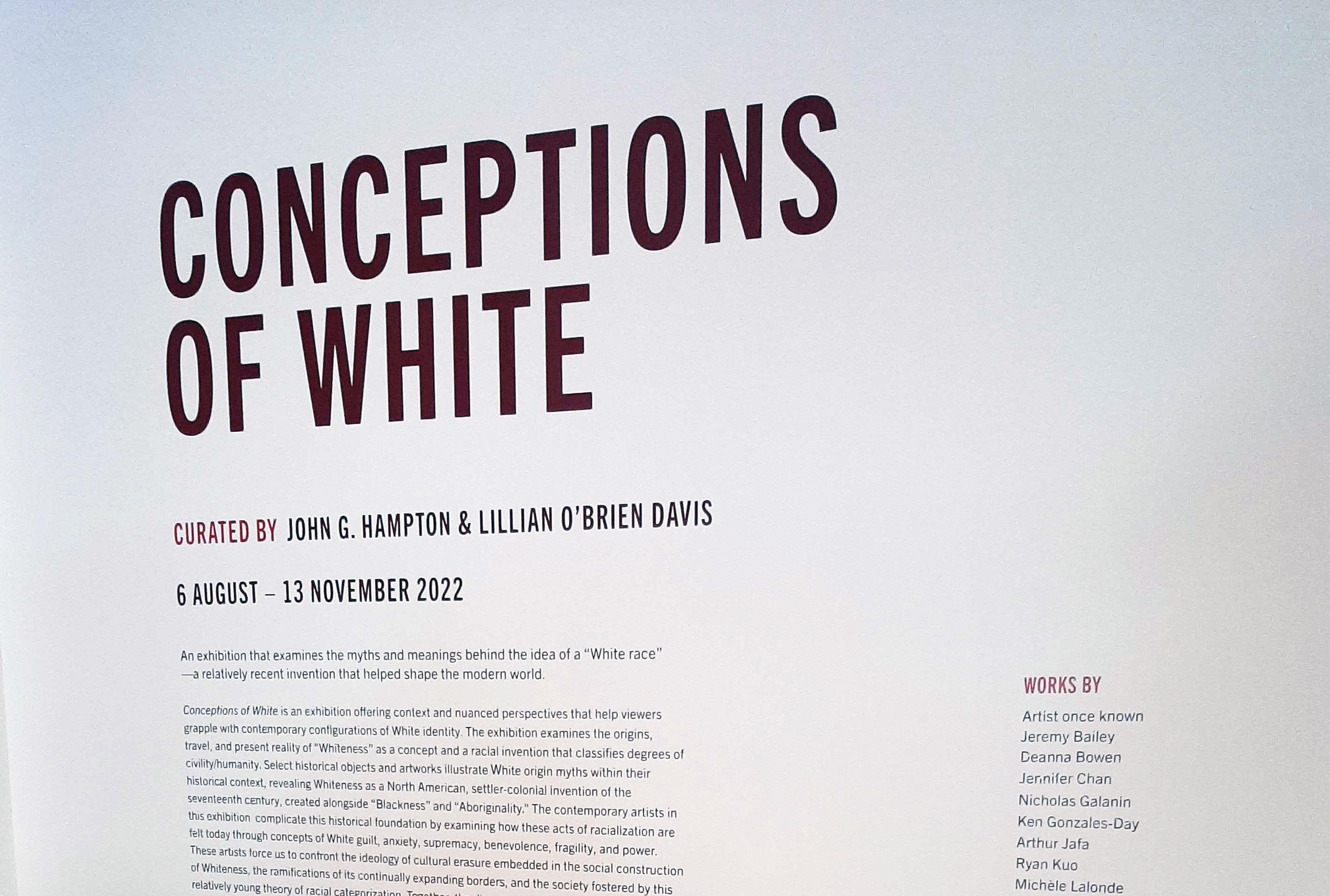
The use of white made the exhibition feel open, larger than it truly was, but the placement of the art pieces balanced that open ness and made you truly look at what was there. It all melded to gether, it was one cohesive exhi bition, but when you stood and looked at one piece, it was sepa rate. It created that perfect mix of collection and individual.
The very first piece you see when you walk in is called Portal It’s a minimalist piece by Robert Morris from 1964. When you walk through this archway, this portal, made from solid white,
of Art History” Johann Joachim Winckelmann saw the sculpture in the Vatican, made of pure white marble and “equated the [...] sculpture’s whiteness with white skin, and proximity to per fection.” He said that “as white is the colour which reflects the greatest number of rays of light, and consequently the most easily perceived, a beautiful body will, accordingly, be the more beautiful the whiter it is.”
Winckelmann’s ideology about the colour white helped implement ideas that White peo
son from 2005. According to the description of the piece, “New York-based artist Fred Wilson is known for creating meaning by bringing various objects into proximity to one another.” The arrangement of objects in Love and Loss in the Milky Way consists of a table, two busts, a sculpture of a woman, and 47 various ob jects that look like cups, plates, and vases. Everything next to each other brings up the question: why? Why does the woman stand above all else? Why are certain objects facing one another? What
of who you are and why, through this piece. You can see “the re lationships between the people, events, and concepts within the material.”
Then, I looked at Ryan Kuo’s File: A Primer. This was a very in teresting installation. Instead of images, sculptures, or videos, this was an animation. It was an ani mation that showed how systems often work, how societal systems keep inside of themselves the things that work for them and they often don’t make space for change. They keep their values
“Enjoy discomfort. Became more approachable in seconds.” When you walk up to it, it prompts you to smile; the more you smile, the more a meter bar fills up and then prompts you to do it again.
The next reads “Check privilege. Learn whether you’re special or just lucky.” When you walk up to it, it spins a wheel and says either “undeserved or deserved.” You get whatever it lands on. Then, there was “Get curious. Vocalize your own ig norance.” This causes a circle to appear over your mouth reading
you walk into the Conceptions of White exhibition. You’re walking through a portal into an entirely new space, a space where every thing is familiar yet different. The archway itself is familiar yet different. We walk through so many archways and passages in our everyday lives, but this one stands out. It’s a clear archway with no walls around it, and it’s broken down to its bare essentials: two sides and a top to connect it. Something so simple leads to something so profound.
The next thing I saw was the statue. The statue was a plaster replica of the famous sculpture Apollo Belvedere. Because it’s a replica of something so fa mous, the statue holds a feeling of uncanny familiarity. “The father
ple are the superior race because of the colour of their skin. While this is obviously not true, Winck elmann’s ideas highly influenced the social construction of White ness.
Past the statue, I looked at Nell Irvin Painter’s Ancient Hair from 2019. It was an image of Painter’s original installation from New Hampshire. The piece discusses the ideas of historical Whiteness. The idea is that peo ple of ancient civilizations could not have been White. She looks specifically at hair and the differ ences between hair in statues and sculptures compared to the hair of people who were claiming that the statues were of White people.
After that was Love and Loss in the Milky Way, a piece by Fred Wil
is the meaning of the placement of each object? I could have spent hours staring at this piece, ques tioning every element of it and what it means.
Afterward, I looked at Dean na Bowen’s White Man’s Burden from 2022. White Man’s Burden is full of newspaper clippings and images about White supremacist groups in Canada. It shows how these groups view themselves as better than everyone else. It also shows how black and white their thinking is, because those pieces are in black and white. The fur ther down the wall you look at this piece, the more colour starts to emerge. The more you see dif ferent kinds of people and the things they do. Bowen melds to gether Canadian culture, the idea
and the things they see as im portant while rejecting everything that doesn’t match. Kuo does this through a file that continues to get more and more full and cha otic while it struggles to keep or der within itself. When it can’t do that, it reverts to a simple, blank file. The animation was simple, yet impactful and incredible.
I was utterly fascinated by what I saw next. Whitesimple by Jeremy Bailey. Whitesimple is an installation of something that re lates heavily to Gen Z: AR filters. I see these constantly on TikTok and Instagram; filters that tell you what kind of pie you are or which Spice Girl you would be. Bailey’s work is about social issues, ideas of race, and ideas of perfor mative activism. The first reads
“Say ‘I know nothing.’” and mi crophone dots to listen to you say it. Finally, there was “Stop talking. Never share an uninvited opinion again.” which made a mute but ton appear over your mouth. This was one of my favourite pieces because it related to me and my generation. It relates to things I see online every single day.
That wasn’t all that was in Conceptions of White, but I didn’t want to give away every thing. Unfortunately, by the time you read this, Conceptions of White will have closed, but the Mackenzie Art Gallery always has new exhibitions coming in, and there’s sure to be something for you.
I love Stardew Valley. There’s something peaceful about farm ing and running around a small town. However, it can be difficult to figure out what to do at the start and the best route to take.
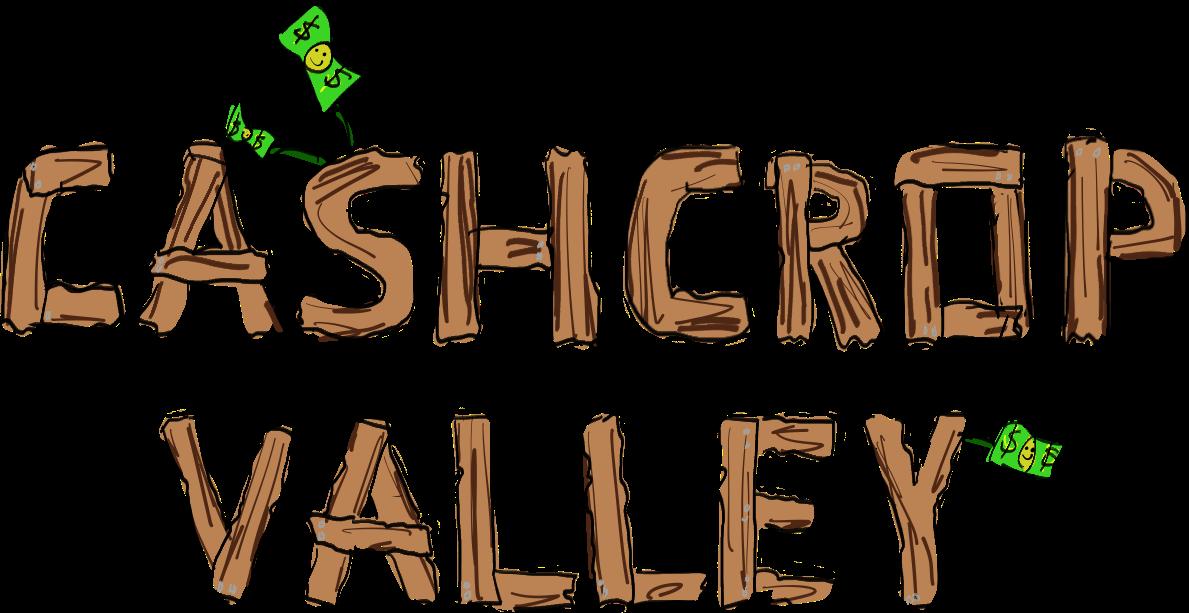
Throughout my near-300 hours of the game, watching speed runs, and chatting with friends, I’ve picked up a few tips and tricks for how to make your gameplay
Foraging is a great way to earn money early on. If you’re having a bad luck day and you can’t go to the mines or you just don’t feel like fishing, you can take a look around town and try to get some good forage. The best days to forage are on Friday and Saturday because the forage re sets on Sundays. If you need just one more piece of forage for that Community Center bundle, go out on a Saturday or a Sunday.

ly, you will catch more fish at the Lonely Rock, but you’ll also catch more fish anywhere else so long as you’re facing left or right instead of up or down.
Plant parsnips first.
When you start up the game, you start with 15 parsnips and 500 gold. Your first instinct may be to go to Pierre’s and buy pota toes with that gold. They’re differ ent from the parsnips; they grow quickly, and they’re not that much

the game before you do it. Stop missing rocks in the mines and stop accidentally destroying your crops. Always see where you’re about to hit before you click with the tool hit location.
Zooming out in the mines.
Arguably the most precious resource in the mines is the lad der. Getting down to that next level can be so important, and it’s especially great when there’s already an open ladder on the
This is the second hack Wren passed on to me. Clear your farm as soon as possible, but not the grass that turns into hay; you’ll need that. If you clear your farm of everything ASAP, grass will start to spread across your whole farm, leaving you with a ton of hay to harvest once you get the silo. It also helps you get resources like wood, stone, fibre, and seeds quickly.
Visit the Traveling Cart.
– Jorah “Cashflow” Brightthe most rewarding in terms of ease, money, and little nuisances.
Save your money for the strawberries.
In the first spring, you’re going to want to upgrade your backpack right away. The inven tory limit can be annoying and frustrating. You end up throwing away things you wanted to keep and not holding on to as much as you want. But don’t go for the backpack right away; that’s 2000 gold. Instead, wait until after the egg festival.
The egg festival is where you
Tool directions for chopping down trees.
Have you ever chopped down a tree only for it to fall into the nearby water? I certainly have. I used to spend so much time try ing to figure out how I needed to stand to chop down trees without losing the wood to the currents of the river. The trick is to stand closer to whichever side you want it to fall. Chopping from the top and wanting it to fall to the right? Stand closer to the right side.
Where you stand when fish ing.
more expensive.
Don’t do that. Don’t buy the potatoes. I know everyone loves potatoes and they’re so versatile, but don’t do it. Instead, stock up on more parsnips. You can have as much as 40 starting parsnips, which is the exact capacity of the watering can. When you har vest all 40 parsnips, you’ll end up with a guaranteed 875 gold when you sell them. Potatoes are uncertain because you don’t know the amount you’ll get at the end. You’ll also get 200xp towards your farming skill versus the 180xp you’d get with the po tatoes, and it’ll only take 4 days to
map. Remember all those times that you dug around looking for a ladder only to realize there was an open ladder already there? Try zooming out. When you zoom out in the mines, more of the area is revealed. You can see whether or not there is an open ladder. The best part is you can set it so the minimize and maximize buttons are part of your HUD so it’s easy to access! This is also a great tool for foraging in larger areas like the Cindersap Forest.

Rebuilding the beach bridge.
This is the first hack that was
Sometimes doing the Com munity Center feels tedious. Some things are difficult to gather. But not with the Traveling Cart lady. On Friday and Sunday, head down to the big tree on Marnie’s Ranch to see what the Traveling Cart has to offer. Yes, it’s expen sive, but it can also be worth it. Get those difficult-to-catch fish and hard-to-find items.
And remember, this is just a game. You play it for fun. If you don’t want to spend your money at the Traveling Cart or buy a ton of strawberries, you don’t have to. The only right way to play the game is to have fun doing it, and what’s most important is that you have fun. Not money, or the aesthetic, or how quickly you complete the Community Center.
the offer here and they accepted me right away. They were the only university in Canada that trusted me and my abilities.”
The Rams started pre-season with a loss to Alberta, 34-11. Al though the Rams lost to Alberta, many on the team felt confident going into their first regular sea son game against Manitoba as the team got to see their rookies shine going into the season. Rams receiver Matt Rivers says that the team was “excited that a bunch of our rookies got the opportunity to do stuff and showcase.” When asked about the team’s mindset going into the season, Rivers said that “we were confident. We had the confidence that we had the players to make it to the Vanier [Cup].” The Rams would then go on to win their first regular season game against the Bisons 33-23.
The 2022-2023 season for the Rams was shaping up to be a strong one, as they would go onto win five out of eight games. The game that would give the Rams the highest confidence going into playoffs was their game against Calgary in week seven when they won 30-7. When asked about what win this season was the most memorable or impactful, Rivers said, “I’d say it was that game against Calgary because our offence started scoring and I remember some-30 points, and it felt like everything was starting to click.”
The Rams’ defence was play ing extremely well all season, but the offence was having difficulties scoring points. The win against Calgary with a 23-point margin gave the Rams even more con fidence going into the playoffs. It meant that they could count on their offence to get the job done just like the defence had been doing all season. However, their toughest competitor would end up being the University of Saskatchewan where the Rams would go on to lose two really close games against the Huskies.
However, after each loss the Rams would bounce back, win ning their next game in great fash ion. When asked what the biggest challenge for this season was for the Rams, Rivers expressed that their biggest challenge was them selves; that when practice was low energy, they knew that they need ed to do better if they wanted to achieve their goals for the season. He also acknowledged that the Rams’ head coach Mark McCon key and assistant head coach Jeff
Stusek played a big role in mak ing sure that the team was locked in during practice, ensuring that the energy levels were high.
The ability for a team to re main confident while holding their teammates accountable on and off the field showcases the strong team culture that the Rams had throughout preseason and all the way through to the playoffs.
Rivers felt that the Rams “were pretty tight as a team. Which, when you go on the field, it’s like, ‘Okay, I’m gonna fight for my brothers’ type of thing.” It meant that everyone took ownership of what was expected of them on and off of the field, whether that was in the weight room or learn ing the team playbook, contribut
ing to their successful season this year.
Rams kicker Aldo Galvan also added that “we had been working with coach McConkey since 2020, during the pandemic, and it was all about culture.” He also cited that McConkey brings in a lot of guest speakers, such as former Rams players who tell stories about their time on the team and what that time in their life meant to them. The history of the Rams is vital to the Rams team culture, as it is important to highlight the past players who have donned the jersey for the Rams. Rams alumni hold a spe cial place within the team culture as many Rams alumni continue to give back to the team in a mul
titude of ways, whether through donations or by attending Rams home games.
When asked about the sup port of the Rams alumni, Rivers said “It gives me a sense of pride. I’m also playing for those who did their time as a Ram. They don’t have to help out, but they do be cause they love the program.”
The strong continued support of Rams alumni throughout the years has helped the team to re main focused and confident on winning the Vanier Cup. The support of Rams alumni should not go unnoticed. When asked about what being a Ram means to him, Galvan stated “I came all the way from Mexico, I didn’t have any idea about Regina. I got
This year, the Rams made the Canada West playoffs for the first time since 2017. The Rams hosted the UBC Thunderbirds at Mosaic Stadium on October 29, which saw a forecast of rain and snow during the game. During the regular season, the Rams beat UBC 21-13. However, the Rams knew that UBC could improve, as Rivers stated “UBC is typically a team that gets better throughout the season.”
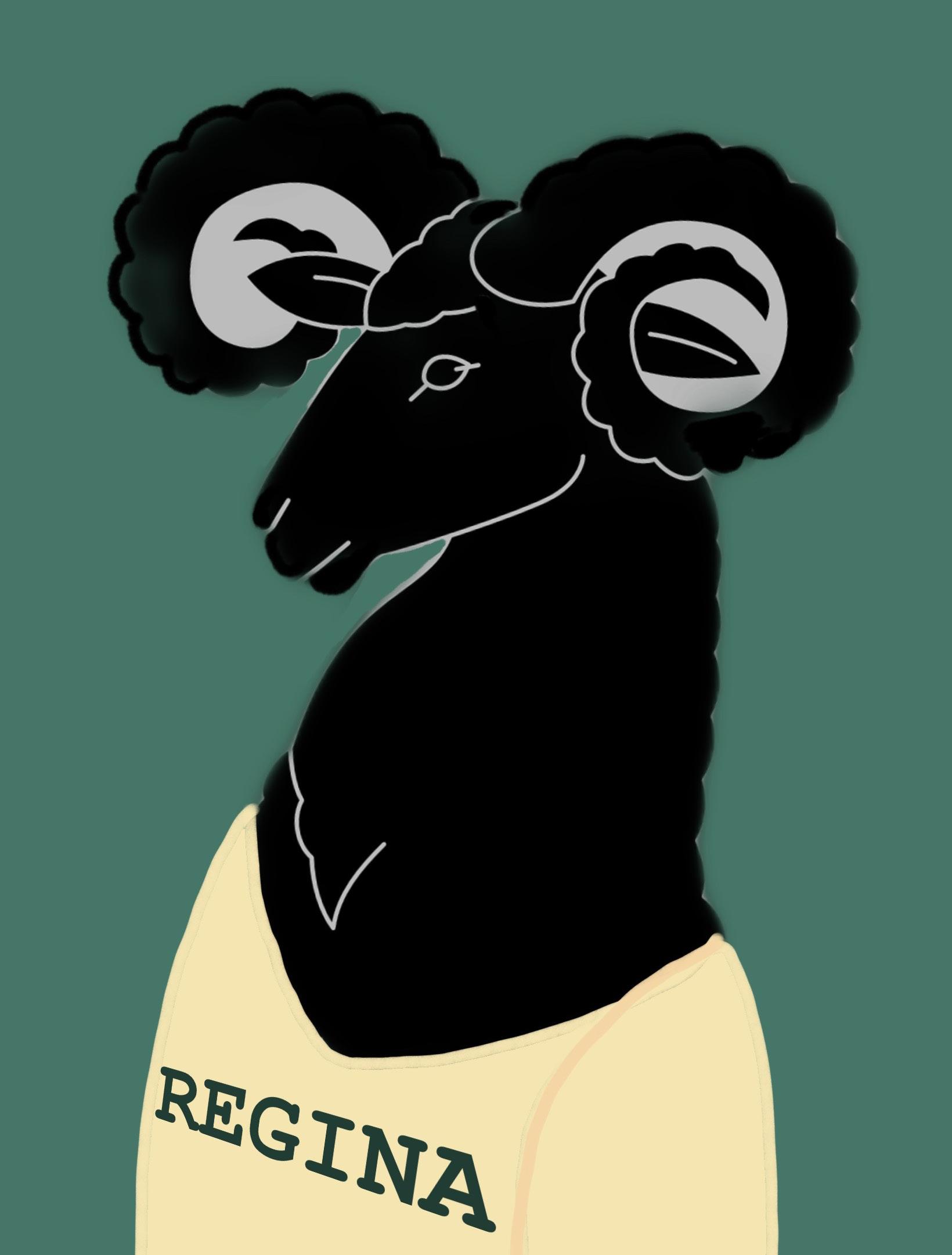
The game was pretty even going into the second quarter. The Rams took the lead with two minutes left in the second quar ter when Rams’ defensive back Donovin Small blocked a punt and recovered the ball for a 58yard run to score a touchdown. The Rams would lead the game 14-12 going into halftime. How ever, after a safety in the third quarter and two UBC touch downs in the fourth, the Thun derbirds would go on to beat the Rams 28-14.
Although the Rams couldn’t capitalize on their opportunities, the stats show a relatively evenmatched game. The Rams had 237 total yards with 147 passing and 135 rushing yards, while the Thunderbirds had 292 total yards with 176 passing and 130 rush ing yards. Both teams were pretty even in first down attempts, with the Thunderbirds having 17 and the Rams having 16. Although the loss to UBC is a devastating way to end a season, it is import ant that the Rams use this experi ence for growth and to get better for next season so they can take advantage when the next oppor tunity arises.
It is also important to high light that five Rams players were chosen as Canada West Defen sive All-Stars: Ryder Varga, Tan ner Schmekel, Anthony Bennett, Jackson Sombach, and Jaxon Ford. Also, Canada West Out standing Defensive Player of the Year went to Rams linebacker Ryder Varga, and Canada West Coach of the Year went to Rams head coach Mark McConkey. These awards showcase the hard work that the Rams put in this season and the payoff their dedi cation had in ensuring that their season was successful.
Our football team sees much acclaim from Canada West as UBC ousts them from the playoffs
sophia stevens s&h writerBah, bah, black sheep, have you any Canada West recognitions?
“It gives me a sense of pride. I’m also playing for those who did their time as a Ram. They don’t have to help out, but they do because they love the program.”
– Matt Rivers, Rams receiver
It seems like there are fewer peo ple in the halls. There are more and more empty seats in lectures. More people are walking around campus with masks on; some for preventative measures and some to contain their cough and run ny nose. If you’ve noticed this too, or if you’ve gotten sick in the past month, you’re not alone. It’s because we’re in store for a nasty winter.
Get ready for the tri-demic. This winter will likely see wide spread infections of three differ ent viruses: influenza, COVID, and respiratory syncytial virus (RSV). Since the pandemic be gan, flu and RSV have, for the most part, been conspicuously absent. Thanks to masking and social distancing mandates, many respiratory illnesses were infect ing far fewer people than usual. This winter is already very, very different.
The 2020-2021 flu season was exceptional. With masking and social distancing mandates in effect, Canada overall had few cases of the flu. The flu’s positiv ity rate – the number of positive tests in a given day divided by the total number of tests adminis tered that day – remained virtual ly zero. The same was true for the 2021-2022 flu season. However, the positivity rate saw a signifi cant spike during the months of March to June of this year.
RSV is a respiratory illness that can impede a person’s ability to breathe. When the virus infects the trachea, bronchi, or lungs, it inflames and swells these areas, making breathing difficult. Like most respiratory illnesses, RSV is dangerous for infants, young children, and the elderly. RSV is especially dangerous for infants and young children since their trachea, bronchi, and lungs are still very small; any swelling and inflammation can cause serious breathing difficulty.
Like the flu, RSV cases were very low during the early stages of the COVID pandemic. During the 2020-2021 season, the positiv
ter.
Already, the flu and RSV have re turned with terrific rage. Both the flu and RSV have positivity rates greater than pre-pandemic levels. Since it’s still early in the cold and flu season, there is no sign that case numbers will peak any time soon. And even if they peak early, that still leaves room for a second wave later in the season.
In a press conference last Thursday, Canada’s chief public health officer Dr. Theresa Tam strongly encouraged Canadians to begin masking again. Dr. Tam reminded Canadians of the role of masking: “If it’s added to the other layers of protection, includ ing vaccination, then it might ac tually make a difference in terms of dampening the surge so that the hospitals can cope just a little bit better.”
It’s a shock to the system: positivity rates are already above pre-pandemic levels. Some Sas katchewan doctors are seeing overwhelming amounts of chil dren coming to their clinics to re ceive treatment for the flu, RSV, and the common cold. Wait times are skyrocketing. Children’s med ications to reduce pain and fever are in severe shortage. According to an article by Sharon Kirkey published on November 9 in the National Post, some Canadian parents are crossing the border to the US to buy Tylenol and Advil for their children due to sparse shelves in Canadian stores.
COVID cases are also, unsurpris ingly, off to an alarming start this season. Higher infection rates of COVID also means the emer gence of new variants. Epidemi ologists predict variants of omi cron will continue to rise. We may feel done with the pandemic, but the pandemic still isn’t finished with us.
Pandemic fatigue is making people much more careless about transmitting and contracting the various respiratory illnesses com mon during the winter months. Vaccination rates are waning as well. Over 80 per cent of Ca nadians have received at least one dose of vaccination against COVID. About half of Canadi ans have gotten one booster shot.
Dr. Gordon Asmundson is a psy chology professor at the U of R and has been studying the psy chology of pandemics for years. No doubt, the past few years have been fertile times for his research.
The pandemic has been disas trous for bodily health, but it has
bia also has “connections to fear of adverse socio-economic conse quences, xenophobia, traumatic stress symptoms, and checking and reassurance seeking.”
In some cases, people with coro naphobia develop maladaptive coping mechanisms as well: pan
tance, and wash your hands. These are the best measures against infection, both physical and mental.
Thankfully, the tri-demic is un likely to become a new nor mal. Flu and RSV infections have been predicted to return to
ity rate of RSV also remained vir tually zero. RSV cases saw a spike in the 2021-2022 season, but these numbers were still signifi cantly lower than pre-pandemic levels.
Data point after data point, graph after graph, the evidence continues to build: masking and social distancing work to prevent respiratory illnesses. The lack of mandates and general pandemic fatigue portends disaster this win

These numbers nosedive for the second booster shot: only about 14 per cent of Canadians.
Now is the winter of our discontent. The outlook is dim.
Thankfully, with a couple years of COVID behind us, we are better equipped now to deal with these tough months ahead. But not only in avoiding infection, we must also avoid the pessimism, anxiety, and depression that the pandemic is wont to cause.
posed serious difficulty for mental health as well.
The pandemic has caused a new anxiety disorder, in fact. It’s called coronaphobia. Dr. Asmundson has contributed re search to understanding this novel phenomenon. Coronapho bia, you may have guessed, is the debilitating fear of contracting COVID. In a 2020 article for the Journal of Anxiety Disorders, As mundson wrote that coronapho
ic buying, excessive avoidance of public spaces, and increased substance abuse. Research on the effects of the pandemic has firmly established that COVID has in tensified many psychological and behavioural problems, includ ing depression, suicidal ideation, OCD, PTSD, substance abuse, and domestic abuse.
Try to avoid doom scrolling too much in the upcoming months. Wear your mask, keep your dis
pre-pandemic levels within one to two years. Nevertheless, the pre vious years of the pandemic have shown undeniably that meaning ful public health measures like masking and social distancing can work to prevent respiratory ill ness. We do it for our own health, but we also do it for the safety of every other person we encounter through our days.
With respiratory illness rates on the rise and supports at an all-time low, here’s what you need to know(Burn, baby burn) respirative inferno. Image: Lee Lim
“Since it’s still early in the cold and flu season, there is no sign that case numbers will peak any time soon. And even if they peak early, that still leaves room for a second wave later in the season.”
– Bodie Robinson
How do you make the most of a day when there is 10 inches of snow right past your door?
victoria baht staff writerThis past weekend, we got a great deal of snow. It appears to have reached around 10 inches of snowfall within 24 hours, mostly overnight. After a good night’s sleep, and with the wind blowing around the snow flakes, you wake up to 10 inches of snow. Here is the question on my mind: do I dare to go out in these conditions, or do I stay indoors? Today, we are going to talk about the options that you have and what my go-tos are to encourage you, or for you to question whether you made the right choice.
If you are someone that chooses to leave the house with all the snow, or has to go to work regardless of the weather, here is some advice that I have for you. First, get some winter tires and put them on your car if you have not done so already. For some one that has owned a variety of small cars with my driving experience, honestly, win ter tires make a great deal of difference.
Second, take your time driving to plac es. When the snow comes down this heavy, I would recommend giving yourself at least an additional 10-15 minutes, as you may have trouble getting through the snow, have traffic moving slowly, or even get stuck in the snow. That is another thing; if you see someone stuck in the snow, and if you have the time or it is safe to help them, help out that person. You never know when you will be stuck and in need of a helping hand.
My third tip when driving in these con ditions is to take your time both when driv ing and stopping. However, this does not mean driving too slowly, as that can also
cause a traffic incident. Make sure that you feel comfortable driving to your destination in this weather, and if you do not feel com fortable maybe try public transportation or just stay home for the day.
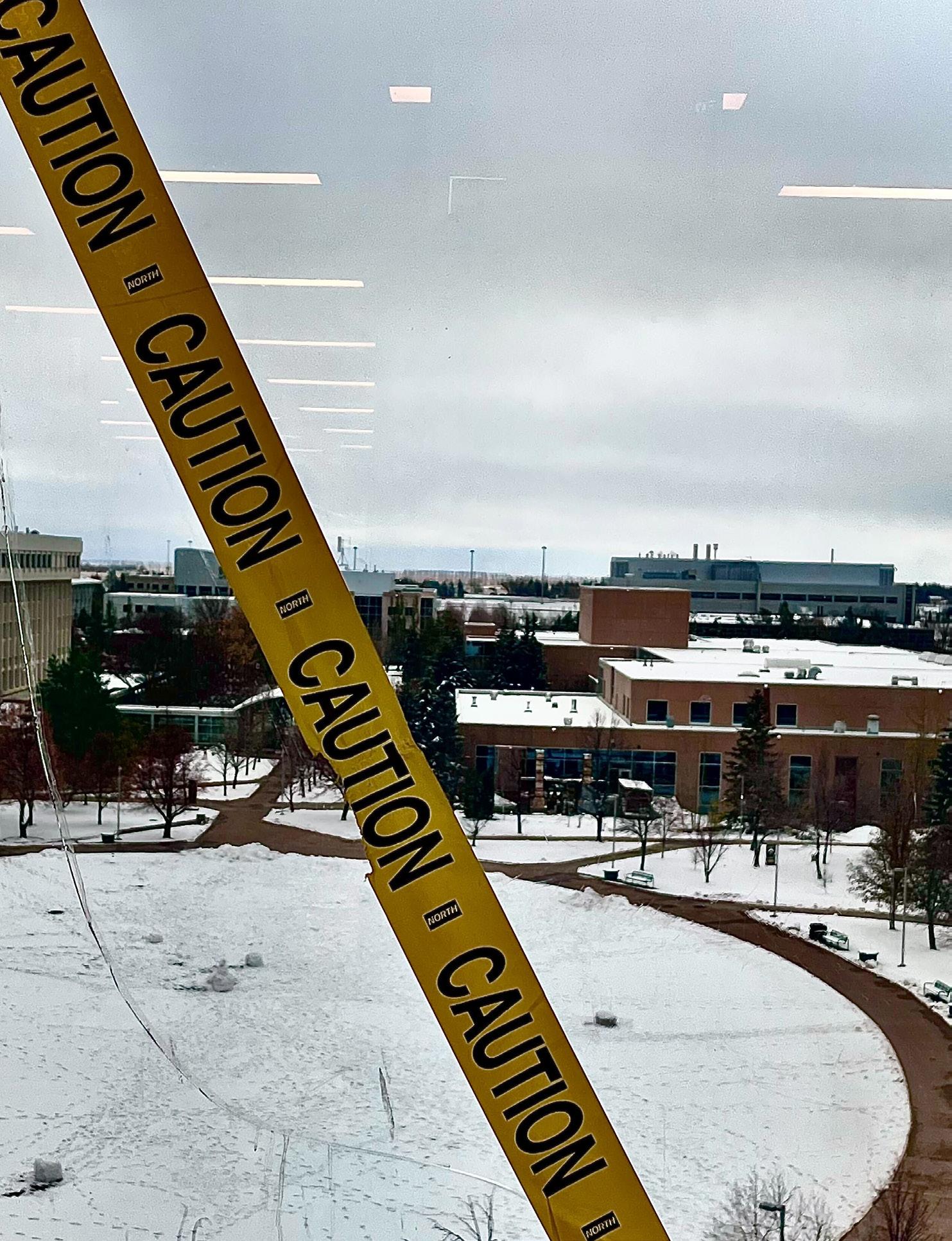
That brings us to our next topic. If you are someone that decides to stay home during this weather, what are your go-tos? A few of my personal favourites are staying nice and warm, whether that means you are all cozied up in sweats and having a Netflix day or keeping your body nice and warm by going and shovelling the snow every three hours. Either is a good choice, and the best part is that you can do both when staying at home.
Once you have watched a few episodes on Netflix or shovelled a couple of times, why not enjoy a nice hot drink? With the colder weather, a few of my go-tos to enjoy on these snowy days are apple cider, hot chocolate, a vanilla latte, or even just a sim ple cup of peppermint tea. As long as you are inside, staying nice and cozy while the snow keeps blowing around.
Winter has just begun this year, which means there will be lots of snow coming down and lots of days where we may spend the entire day inside, or have to spend the day outside. I hope this article gave you some advice or reflected on what your weekend may have looked like.
As the snow keeps coming down you may be faced with these options a few times. What will be your choice next time? Tell us about it! The Carillon would love to hear all about your most (or least) favour ite winter hobbies for these long dreadful months.

Most post-secondary institutions offer some form of socializing outside of aca demics. These opportunities are where I made my friends at the university. I sat on URSU’s board of directors, ran a student society, volunteered with the Ambassador program, and even attended a few events put on by residence services.
The people I consider my closest and truest friends are from these events. When things get tough, I know I can rely on them to help me if needed, or just offer their support. Reflecting on it, I’m not sure how many of us would have met had it not been for the various activities I was involved in.
During my time at URSU, I can cer tainly say that it wasn’t easy for a variety of reasons. But I would be lying if I said I learned nothing. I learned how to navigate toxic workplace relationships, when to just ignore certain things and people, how to prioritize doing the right thing even if oth ers don’t always agree, and how to make sure that I can say I did my best at the end of the day. I sat on the disciplinary commit tee and student appeals committee, where I was able to shine light on the point of view of students to the university administration who may not have experienced what it is like to be a student today.
I also learned a bit more about how the administration and management of the university works. I think this a unique ex
perience that more students should be able to participate in because of how valuable it is to understand how to communicate with others who hold a lot of power over you by virtue of their roles. The university was very good at not using the power dynamic to influence opinions, which is quite hon estly rare to find.
I know I put in thousands of dollars to get my education and not everyone can afford to do that, so I know I am very priv ileged to be where I am today. Having had these opportunities has shown me how much value we can add to society by reduc ing the costs of going to university. I also completely understand the people who do not wish to go due to stress and/or work load, and know that university is not for everyone. I just don’t think that cost should be as big of a factor as it is now.
Student loans only recently got some boosts to help students with the sheer amounts of debt with the new changes to the Repayment Assistance Program, where you can delay the start of payments until you make over $40,000, and the federal government removing the interest on fed eral student loan amounts.
As I reflect back on my student expe rience, I feel like I had a pretty good ex perience overall. While some people had me questioning if what I was doing was even worth the mental strain I was being put under, I had friends under similar pres sures, so there are different support systems wherever it may be needed. Looking at my
the reason why some of us no longer have any faith in humanity.
overall experience, support systems are how I succeeded and this is the reality for many. In the end, while you may only get what you put into education, you cannot light the candle at both ends and hope for
success. Sometimes your support system is just you, and that’s okay, because some times the only one you need to succeed for is yourself.

The modern highway is the place where most hard-working citizens spend their early mornings and late afternoons. Once it was a place of peace, where the average American could contemplate their lives and be proud of a hard day’s work. When our grandfathers were caring for our families, the road was populated by Beetles, Plym ouths, and the simple pickup truck. Society as a whole was able to once enjoy a com mute, whether it was to work, the store, or even simply to a friend’s home. Nowadays such an idea is completely unheard of, and you may be asking yourself what so many before have already asked: why?
The answer is simple, folks. Modern vehicle design is killing America. Yes, it’s true. Whether it’s Ford, Dodge, or even a foreign company like Mercedes, the new design model that is perverting our society is anti-American, anti-patriotism, and an ti-you.

It wasn’t long ago – back when men were men and we were proud to stand for the anthem – that our vehicles and our highways were places of respite. But now you, just as every other American, suffer from a constant stream of oversized behe moth vehicles that take up the entirety of the roadway with their mere presence. Tell me, my fellow Americans, why on earth do we stand by and let these tyrannical despots, these automotive authoritarians, those gasoline-guzzling gestapos ruin the sacred tranquility that comes with our dai ly commutes? Is it because we, as a society, are failing? Is America finally crumbling due to our own apathies?
I say no, this is not a failure on our part. We as citizens demand that our gov ernment protect us from foreign threats to our safety and well-being, so why do they not also protect us from the domestic ter rorism that is the Dodge 3500? The answer is simple, folks. The Coward-In-Chief Joe Biden is obviously beholden to Big-Auto motives.
Now, you might be wondering how modern vehicle design is truly beginning to destroy the foundations of our once great country, and the answer is simple. Where once a red-blooded American’s commute would have been an opportunity to reflect
and to appreciate the beautiful land we call home, it is now filled with stress. Our drives are a constant battle against the automo tive overlords to simply stay alive.
No longer do you get the simple plea sure of a quiet drive to or from. No, now you must be in rigorous competition with the whirling death-traps that plague you from all sides. You have had yet another right stripped from you as a result of the automotive and corporate pandering that has pervaded the entirety of the Biden ad ministration. Do you truly think that it is merely a coincidence that the thing used to transport the president from one lie-filled
conference to another is the largest and statistically most dangerous piece of equip ment ever known to man? Think again.
My fellow Americans, now more than ever we must band together to fight against the destruction of yet another proud American way of life. With your donations, Dog Newz will begin that fight, but it is up to you, the citizen, to continue it. In your homes, in your streets, and in the upcom ing elections. Stand with us, and together we can begin to put this once great country back on the road.
Dog Newz correspondent writes satiric propaganda about nothing that makes any senseWith gas prices what they are, one often wonders if owners of these huge trucks are questioning their life choices.
always a couple of years behind...holly funk editor-in-chief
